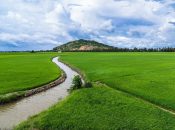Irrigation systems are diverse and essential tools in agriculture, designed to deliver water effectively and efficiently to crops, ensuring optimal growth and yield. These systems vary widely based on factors like terrain, crop types, and water availability, and they employ different methods to distribute water.
One common system is surface irrigation, where water flows across the field through gravity, saturating the soil and reaching plant roots. This method includes furrow irrigation, where water runs along channels or furrows between crop rows, and flood irrigation, where fields are flooded entirely. While relatively simple, these methods may lead to uneven water distribution and potential wastage.
Another prevalent technique is sprinkler irrigation, which uses pressurized water delivered through sprinklers or sprayers. This system mimics natural rainfall, evenly distributing water over the field. It offers flexibility in application and can cover larger areas, making it suitable for various crops and terrains.
Drip irrigation, a highly efficient method, delivers water directly to the plant roots through a network of pipes and emitters. This precise system minimizes water loss due to evaporation or runoff, conserving water and optimizing plant growth. It’s particularly beneficial in arid regions or for crops requiring specific moisture levels.
Subsurface irrigation involves delivering water directly below the soil surface, either through buried pipes or tubes. This method reduces water evaporation and minimizes soil surface wetness, preventing water loss and soil erosion.
The choice of irrigation system depends on factors like crop type, soil type, climate, and available water resources. Modern systems often integrate technology, such as sensors and automation, to optimize water usage and improve efficiency, contributing to sustainable agriculture while maximizing crop productivity.

Drip Irrigation
Here are 14 interesting facts about irrigation system to know more about it.
- Ancient Origins: Irrigation systems date back thousands of years, with evidence of early systems found in ancient civilizations like the Mesopotamians, Egyptians, and Chinese.
- Hydraulic Engineering: The construction of elaborate aqueducts, canals, and dikes by ancient societies showcases advanced hydraulic engineering used in irrigation.
- Global Impact: Irrigation systems support agriculture across the globe, contributing significantly to food production and sustaining economies.
- Varied Methods: Methods range from surface irrigation (flood and furrow) to sprinkler, drip, and subsurface irrigation, each catering to specific agricultural needs.
- Water Efficiency: Drip irrigation is highly efficient, delivering water directly to plant roots and reducing water wastage through evaporation or runoff.
- Precision Agriculture: Modern systems integrate technology like sensors and automation for precise water delivery, optimizing crop growth and resource usage.
- Terrain Adaptation: Irrigation systems are adaptable to various terrains, allowing cultivation in diverse landscapes, from flat plains to sloped terrains.
- Crop Diversity: Different irrigation methods cater to a wide array of crops, including staple grains, fruits, vegetables, and cash crops, enhancing agricultural diversity.
- Climate Resilience: Efficient irrigation helps mitigate the impact of climate change by providing consistent water access even in regions prone to erratic rainfall patterns.
- Water Source Management: Irrigation systems use diverse water sources, including rivers, reservoirs, groundwater, and even treated wastewater, ensuring resource diversity.
- Soil Conservation: Properly managed systems help prevent soil erosion by maintaining optimal soil moisture levels and minimizing surface runoff.
- Energy Consumption: Pumping water for irrigation requires significant energy, contributing to overall energy demands, particularly in large-scale systems.
- Challenges in Water Allocation: Water rights and allocations often lead to complex legal and social issues, especially in regions with competing water demands.
- Sustainable Innovations: Ongoing research focuses on developing sustainable irrigation technologies to balance agricultural needs with environmental conservation.
Irrigation systems serve as the lifeblood of agriculture, connecting the vital dots between water resources and crop growth. From ancient aqueducts to modern precision systems, their evolution mirrors human ingenuity in harnessing water for sustenance. Yet, as crucial as they are, these systems also confront challenges—balancing water conservation, energy demands, and environmental impact. The future of irrigation lies in sustainable practices, technological innovations, and responsible water management, striving not only to cultivate bountiful harvests but also to preserve our precious water resources for generations to come.





